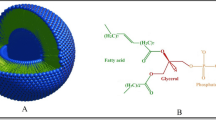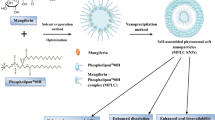Abstract
It is well known that flavonoids can chelate transition metals. Flavonoid-metal complexes exhibit a high antioxidative and therapeutic potential. However, the complexes are frequently hydrophobic ones and low soluble in water, which restricts their medical applications. Integration of these complexes into liposomes may increase their bioavailability and therapeutic effect. Here, we studied the interaction of quercetin-iron complexes with dimyristoylphosphatidylcholine (DMPC) or palmitoyl-oleoyl phosphatidylethanolamine (POPE) multilamellar liposomes. Differential scanning calorimetry (DSC) and freeze-fracture electron microscopy revealed that quercetin-iron complexes did not interact with liposomes. Quercetin however could penetrate lipid bilayers, when added to liposomes at a temperature above lipid melting. Iron cations added later penetrated into the lipid bilayers and produced complexes with quercetin in the liposomes. The quercetin-iron entry in POPE liposomes was improved when the suspension was heated above the temperature of the bilayer-hexagonal HII phase transition of the lipid. The approach proposed facilitates the integration of quercetin-iron complexes into liposomes and may promote their use in medicine.





Similar content being viewed by others
Abbreviations
- DMPC:
-
1,2-Dimyristoyl-sn-glycero-3-phosphocholine
- POPE:
-
1-Palmitoyl-2-oleoyl-sn-glycero-3-phosphoethanolamine
- DSC:
-
Differential scanning calorimetry
- T p :
-
Temperature of pretransition
- T m :
-
Temperature of the main phase transition
- T h :
-
Temperature of transition from the bilayer to the hexagonal HII phase
References
Solanki, I., Parihar, P., Mansuri, M. L., & Parihar, M. S. (2015). Flavonoid-based therapies in the early management of neurodegenerative diseases. Advances in Nutrition, 6, 64–72.
Sak, K. (2014). Cytotoxicity of dietary flavonoids on different human cancer types. Pharmacognosy Reviews, 8, 122–146.
Joven, J., Micol, V., Segura-Carretero, A., Alonso-Villaverde, C., & Menendez, J. A. (2014). Polyphenols and the modulation of gene expression pathways: can we eat our way out of the danger of chronic disease? Critical Reviews in Food Science and Nutrition, 54, 985–1001.
Vauzour, D. (2014). Effect of flavonoids on learning, memory and neurocognitive performance: relevance and potential implications for Alzheimer’s disease pathophysiology. Journal of the Science of Food and Agriculture, 94, 1042–1056.
Vuong, Q. V. (2014). Epidemiological evidence linking tea consumption to human health: a review. Critical Reviews in Food Science and Nutrition, 54, 523–536.
Nile, S. H., & Park, S. W. (2014). Edible berries: bioactive components and their effect on human health. Nutrition, 30, 134–144.
Mignet, N., Seguin, J., & Chabot, G. G. (2013). Bioavailability of polyphenol liposomes: a challenge ahead. Pharmaceutics, 5, 457–471.
Gibis, M., Vogt, E., & Weiss, J. (2012). Encapsulation of polyphenolic grape seed extract in polymer-coated liposomes. Food & Function, 3, 246–254.
Cai, X., Fang, Z., Dou, J., Yu, A., & Zhai, G. (2013). Bioavailability of quercetin: problems and promises. Current Medicinal Chemistry, 20, 2572–2582.
Park, S. N., Lee, M. H., Kim, S. J., & Yu, E. R. (2013). Preparation of quercetin and rutin-loaded ceramide liposomes and drug-releasing effect in liposome-in-hydrogel complex system. Biochemical and Biophysical Research Communications, 435, 361–366.
Caddeo, C., Diez-Sales, O., Pons, R., Fernandez-Busquets, X., Fadda, A. M., & Manconi, M. (2014). Topical anti-inflammatory potential of quercetin in lipid-based nanosystems: in vivo and in vitro evaluation. Pharmaceutical Research, 31, 959–968.
Castangia, I., Nacher, A., Caddeo, C., Valenti, D., Fadda, A. M., Diez-Sales, O., Ruiz-Sauri, A., & Manconi, M. (2014). Fabrication of quercetin and curcumin bionanovesicles for the prevention and rapid regeneration of full-thickness skin defects on mice. Acta Biomaterialia, 10, 1292–1300.
Liu, D., Hu, H., Lin, Z., Chen, D., Zhu, Y., Hou, S., & Shi, X. (2013). Quercetin deformable liposome: preparation and efficacy against ultraviolet B induced skin damages in vitro and in vivo. Journal of Photochemistry and Photobiology B, 127, 8–17.
Liu, H., Xue, J. X., Li, X., Ao, R., & Lu, Y. (2013). Quercetin liposomes protect against radiation-induced pulmonary injury in a murine model. Oncology Letters, 6, 453–459.
Cadena, P. G., Pereira, M. A., Cordeiro, R. B., Cavalcanti, I. M., Barros, N. B., Pimentel, M. C., Lima Filho, J. L., Silva, V. L., & Santos-Magalhaes, N. S. (2013). Nanoencapsulation of quercetin and resveratrol into elastic liposomes. Biochimica et Biophysica Acta, 1828, 309–316.
Wang, G., Wang, J. J., Chen, X. L., Du, S. M., Li, D. S., Pei, Z. J., Lan, H., & Wu, L. B. (2013). The JAK2/STAT3 and mitochondrial pathways are essential for quercetin nanoliposome-induced C6 glioma cell death. Cell Death & Disease, 4, e746.
Long, Q., Xiel, Y., Huang, Y., Wu, Q., Zhang, H., Xiong, S., Liu, Y., Chen, L., Wei, Y., Zhao, X., & Gong, C. (2013). Induction of apoptosis and inhibition of angiogenesis by PEGylated liposomal quercetin in both cisplatin-sensitive and cisplatin-resistant ovarian cancers. Journal of Biomedical Nanotechnology, 9, 965–975.
Gang, W., Jie, W. J., Ping, Z. L., Ming, D. S., Ying, L. J., Lei, W., & Fang, Y. (2012). Liposomal quercetin: evaluating drug delivery in vitro and biodistribution in vivo. Expert Opinion on Drug Delivery, 9, 599–613.
He, B., Wang, X., Shi, H. S., Xiao, W. J., Zhang, J., Mu, B., Mao, Y. Q., Wang, W., & Wang, Y. S. (2013). Quercetin liposome sensitizes colon carcinoma to thermotherapy and thermochemotherapy in mice models. Integrative Cancer Therapies, 12, 264–270.
Saija, A., Tomaino, A., Trombetta, D., Pellegrino, M. L., Tita, B., Messina, C., Bonina, F. P., Rocco, C., Nicolosi, G., & Castelli, F. (2003). ‘In vitro’ antioxidant and photoprotective properties and interaction with model membranes of three new quercetin esters. European Journal of Pharmaceutics and Biopharmaceutics, 56, 167–174.
Pawlikowska-Pawlega, B., Dziubinska, H., Krol, E., Trebacz, K., Jarosz-Wilkolazka, A., Paduch, R., Gawron, A., & Gruszecki, W. I. (2014). Characteristics of quercetin interactions with liposomal and vacuolar membranes. Biochimica et Biophysica Acta, 1838, 254–265.
Barrajon-Catalan, E., Herranz-Lopez, M., Joven, J., Segura-Carretero, A., Alonso-Villaverde, C., Menendez, J. A., & Micol, V. (2014). Molecular promiscuity of plant polyphenols in the management of age-related diseases: far beyond their antioxidant properties. Advances in Experimental Medicine and Biology, 824, 141–159.
Harasym, J., & Oledzki, R. (2014). Effect of fruit and vegetable antioxidants on total antioxidant capacity of blood plasma. Nutrition, 30, 511–517.
Han, R. M., Zhang, J. P., & Skibsted, L. H. (2012). Reaction dynamics of flavonoids and carotenoids as antioxidants. Molecules, 17, 2140–2160.
Galleano, M., Verstraeten, S. V., Oteiza, P. I., & Fraga, C. G. (2010). Antioxidant actions of flavonoids: thermodynamic and kinetic analysis. Archives of Biochemistry and Biophysics, 501, 23–30.
Terao, J. (2009). Dietary flavonoids as antioxidants. Forum of Nutrition, 61, 87–94.
Kostyuk, V. A., Potapovich, A. I., Strigunova, E. N., Kostyuk, T. V., & Afanas’ev, I. B. (2004). Experimental evidence that flavonoid metal complexes may act as mimics of superoxide dismutase. Archives of Biochemistry and Biophysics, 428, 204–208.
Kostyuk, V. A., Potapovich, A. I., Kostyuk, T. V., & Cherian, M. G. (2007). Metal complexes of dietary flavonoids: evaluation of radical scavenger properties and protective activity against oxidative stress in vivo. Cellular and Molecular Biology, 53, 62–69.
Afanas’eva, I. B., Ostrakhovitch, E. A., Mikhal’chik, E. V., Ibragimova, G. A., & Korkina, L. G. (2001). Enhancement of antioxidant and anti-inflammatory activities of bioflavonoid rutin by complexation with transition metals. Biochemical Pharmacology, 61, 677–684.
Kopacz, M., Woznicka, E., & Gruszecka, J. (2005). Antibacterial activity of morin and its complexes with La (III), Gd (III) and Lu (III) ions. Acta Poloniae Pharmaceutica, 62, 65–67.
Kim, Y. A., Tarahovsky, Y. S., Yagolnik, E. A., Kuznetsova, S. M., & Muzafarov, E. N. (2013). Lipophilicity of flavonoid complexes with iron (II) and their interaction with liposomes. Biochemical and Biophysical Research Communications, 431, 680–685.
Wang, X. X., Li, Y. B., Yao, H. J., Ju, R. J., Zhang, Y., Li, R. J., Yu, Y., Zhang, L., & Lu, W. L. (2011). The use of mitochondrial targeting resveratrol liposomes modified with a dequalinium polyethylene glycol-distearoylphosphatidyl ethanolamine conjugate to induce apoptosis in resistant lung cancer cells. Biomaterials, 32, 5673–5687.
Sanchez, M., Aranda, F. J., Teruel, J. A., & Ortiz, A. (2011). New pH-sensitive liposomes containing phosphatidylethanolamine and a bacterial dirhamnolipid. Chemistry and Physics of Lipids, 164, 16–23.
Teong, B., Kuo, S. M., Chen, C. H., Chen, Y. K., Cheng, Z. J., & Huang, H. H. (2014). Characterization and human osteoblastic proliferation- and differentiation-stimulatory effects of phosphatidylcholine liposomes-encapsulated propranolol hydrochloride. Biomedical Materials and Engineering, 24, 1875–1887.
Cruz-Leal, Y., Machado, Y., Lopez-Requena, A., Canet, L., Laborde, R., Alvares, A. M., Lucatelli Laurindo, M. F., Santo Tomas, J. F., Alonso, M. E., Alvarez, C., Mortara, R. A., Popi, A. F., Mariano, M., Perez, R., & Lanio, M. E. (2014). Role of B-1 cells in the immune response against an antigen encapsulated into phosphatidylcholine-containing liposomes. International Immunology, 26, 427–437.
MacDonald, R. C., MacDonald, R. I., Menco, B. P., Takeshita, K., Subbarao, N. K., & Hu, L. R. (1991). Small-volume extrusion apparatus for preparation of large, unilamellar vesicles. Biochimica et Biophysica Acta, 1061, 297–303.
Tarahovsky, Y. S., Deev, A. A., Masulis, I. S., & Ivanitsky, G. R. (1998). Structural organization and phase behavior of DNA-calcium-dipalmitoylphosphatidylcholine complex. Biochemistry (Moscow), 63, 1126–1131.
Barcelo, F., Prades, J., Encinar, J. A., Funari, S. S., Vogler, O., Gonzalez-Ros, J. M., & Escriba, P. V. (2007). Interaction of the C-terminal region of the Ggamma protein with model membranes. Biophysical Journal, 93, 2530–2541.
Matuoka, S., Kato, S., & Hatta, I. (1994). Temperature change of the ripple structure in fully hydrated dimyristoylphosphatidylcholine/cholesterol multibilayers. Biophysical Journal, 67, 728–736.
Wang, X., Semmler, K., Richter, W., & Quinn, P. J. (2000). Ripple phases induced by alpha-tocopherol in saturated diacylphosphatidylcholines. Archives of Biochemistry and Biophysics, 377, 304–314.
Suwalsky, M., Martinez, F., Cardenas, H., Grzyb, J., & Strzalka, K. (2005). Iron affects the structure of cell membrane molecular models. Chemistry and Physics of Lipids, 134, 69–77.
Kasvosve, I., & Delanghe, J. (2002). Total iron binding capacity and transferrin concentration in the assessment of iron status. Clinical Chemistry and Laboratory Medicine, 40, 1014–1018.
Marsh, D. (2011). Pivotal surfaces in inverse hexagonal and cubic phases of phospholipids and glycolipids. Chemistry and Physics of Lipids, 164, 177–183.
Funari, S. S., Rebbin, V., Marzorati, L., & di Vitta, C. (2011). Membrane morphology modifications induced by hydroquinones. Langmuir, 27, 8257–8262.
Tenchov, B., Koynova, R., & Rapp, G. (2001). New ordered metastable phases between the gel and subgel phases in hydrated phospholipids. Biophysical Journal, 80, 1873–1890.
Dabbagh-Bazarbachi, H., Clergeaud, G., Quesada, I. M., Ortiz, M., O’Sullivan, C. K., & Fernandez-Larrea, J. B. (2014). Zinc ionophore activity of quercetin and epigallocatechin-gallate: from hepa 1–6 cells to a liposome model. Journal of Agricultural and Food Chemistry, 62, 8085–8093.
Acknowledgments
This study was supported by RFFI grants 13-04-97526 and 14-04-31308, Russian Federation.
Compliance with Ethical Standards
We believe that the presented research complies with the ethical rules applicable for the journal Applied Biochemistry and Biotechnology
Author information
Authors and Affiliations
Corresponding author
Rights and permissions
About this article
Cite this article
Kim, Y.A., Tarahovsky, Y.S., Yagolnik, E.A. et al. Integration of Quercetin-Iron Complexes into Phosphatidylcholine or Phosphatidylethanolamine Liposomes. Appl Biochem Biotechnol 176, 1904–1913 (2015). https://doi.org/10.1007/s12010-015-1686-z
Received:
Accepted:
Published:
Issue Date:
DOI: https://doi.org/10.1007/s12010-015-1686-z




